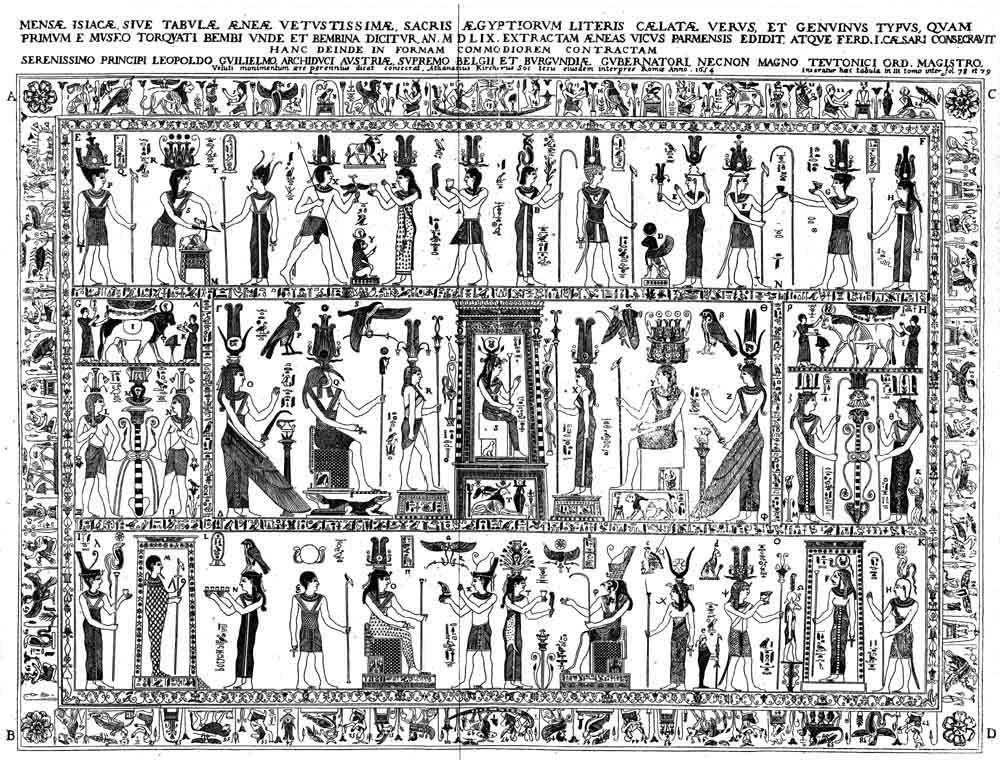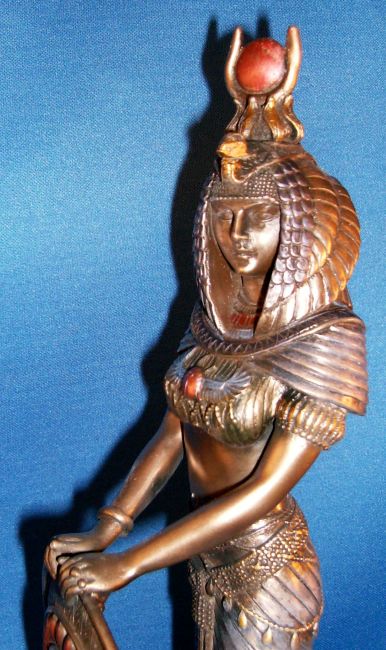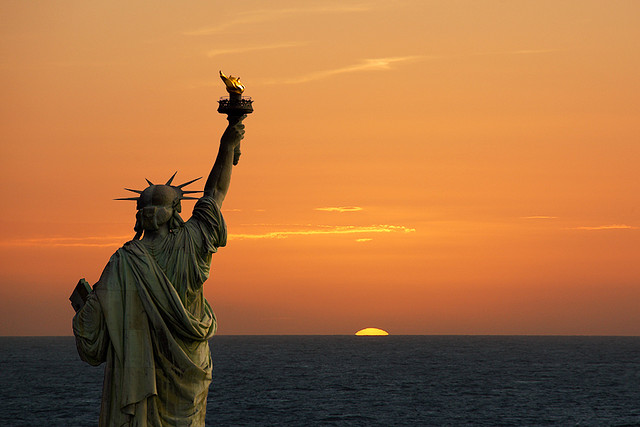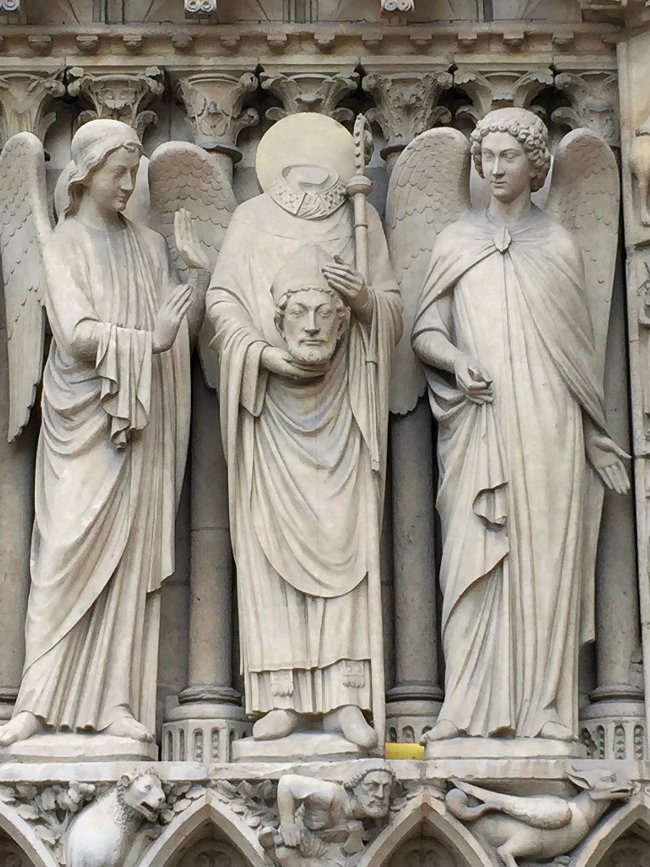p. 45
IT is especially fitting that a study of Hermetic symbolism should begin with a discussion of the symbols and attributes of the Saitic Isis. This is the Isis of Sais, famous for the inscription concerning her which appeared on the front of her temple in that city: “I, Isis, am all that has been, that is or shall be; no mortal Man hath ever me unveiled.”
Plutarch affirms that many ancient authors believed this goddess to be the daughter of Hermes; others held the opinion that she was the child of Prometheus. Both of these demigods were noted for their divine wisdom. It is not improbable that her kinship to them is merely allegorical. Plutarch translates the name Isis to mean wisdom. Godfrey Higgins, in his Anacalypsis, derives the name of Isis from the Hebrew ישע, Iso, and the Greek ζωω, to save. Some authorities, however, for example, Richard Payne Knight (as stated in his Symbolical Language of Ancient Art and Mythology), believe the word to be of Northern extraction, possibly Scandinavian or Gothic. In these languages the name is pronounced Isa, meaning ice, or water in its most passive, crystallized, negative state.
This Egyptian deity under many names appears as the principle of natural fecundity among nearly all the religions of the ancient world. She was known as the goddess with ten thousand appellations and was metamorphosed by Christianity into the Virgin Mary, for Isis, although she gave birth to all living things–chief among them the Sun–still remained a virgin, according to the legendary accounts.
Apuleius in the eleventh book of The Golden Ass ascribes to the goddess the following statement concerning her powers and attributes: “Behold, * *, I, moved by thy prayers, am present with thee; I, who am Nature, the parent of things, the queen of all the elements, the primordial progeny of ages, the supreme of Divinities, the sovereign of the spirits of the dead, the first of the celestials, and the uniform resemblance of Gods and Goddesses. I, who rule by my nod the luminous summits of the heavens, the salubrious breezes of the sea, and the deplorable silences of the realms beneath, and whose one divinity the whole orb of the earth venerates under a manifold form, by different rites and a variety of appellations. Hence the primogenial Phrygians call me Pessinuntica, the mother of the Gods, the Attic Aborigines, Cecropian Minerva; the floating Cyprians, Paphian Venus; the arrow-bearing Cretans, Diana Dictynna; the three-tongued Sicilians, Stygian Proserpine; and the Eleusinians, the ancient Goddess Ceres. Some also call me Juno, others Bellona, others Hecate, and others Rhamnusia. And those who are illuminated by the incipient rays of that divinity the Sun, when he rises, viz. the Ethiopians, the Arii, and the Egyptians skilled in ancient learning, worshipping me by ceremonies perfectly appropriate, call me by my true name, Queen Isis.”
Le Plongeon believes that the Egyptian myth of Isis had a historical basis among the Mayas of Central America, where this goddess was known as Queen Moo. In Prince Coh the same author finds a correspondence to Osiris, the brother-husband of Isis. Le Plongeon’s theory is that Mayan civilization was far more ancient than that of Egypt. After the death of Prince Coh, his widow, Queen Moo, fleeing to escape the wrath of his murderers, sought refuge among the Mayan colonies in Egypt, where she was accepted as their queen and was given the name of Isis. While Le Plongeon may be right, the possible historical queen sinks into insignificance when compared with the allegorical, symbolic World Virgin; and the fact that she appears among so many different races and peoples discredits the theory that she was a historical individual.
According to Sextus Empyricus, the Trojan war was fought over a statue of the moon goddess. For this lunar Helena, and not for a woman, the Greeks and Trojans struggled at the gates of Troy.
Several authors have attempted to prove that Isis, Osiris, Typhon, Nephthys, and Aroueris (Thoth, or Mercury) were grandchildren of the great Jewish patriarch Noah by his son Ham. But as the story of Noah and his ark is a cosmic allegory concerning the repopulation of planets at the beginning of each world period, this only makes it less likely that they were historical personages. According to Robert Fludd, the sun has three properties–life, light, and heat. These three vivify and vitalize the three worlds–spiritual, intellectual, and material. Therefore, it is said “from one light, three lights,” i. e. the first three Master Masons. In all probability, Osiris represents the third, or material, aspect of solar activity, which by its beneficent influences vitalizes and enlivens the flora and fauna of the earth. Osiris is not the sun, but the sun is symbolic of the vital principle of Nature, which the ancients knew as Osiris. His symbol, therefore, was an opened eye, in honor of the Great Eye of the universe, the sun. Opposed to the active, radiant principle of impregnating fire, hear, and motion was the passive, receptive principle of Nature.

Moe is the founder of GnosticWarrior.com. He is a father, husband, author, martial arts black belt, and an expert in Gnosticism, the occult, and esotericism.

![How a little boy, dying in the same monastery, called upon a virgin that was to follow him; and how another nun, at the point of leaving her body, saw some small part of the future glory [675 A. D.?] | Book 4 | Chapter 8 How a little boy, dying in the same monastery, called upon a virgin that was to follow him; and how another nun, at the point of leaving her body, saw some small part of the future glory [675 A. D.?] | Book 4 | Chapter 8](https://www.gnosticwarrior.com/wp-content/plugins/contextual-related-posts/default.png)






